Nanophosphors-Based White Light Sources
Abstract
1. Introduction
2. Phosphors and Phosphor-Converted Solid-State Lighting Sources: Background
2.1. Phosphors and Luminescence Mechanisms
- thermally and chemically stable crystalline materials that inherently contain luminescent centers,
- optically inactive materials (termed host crystals) doped with optimized concentrations and kind of luminescent ions (activators, sensitizers, activator–sensitizer pairs), and
- defect-related luminescent materials that emit under proper concentration of the defect and/or reaction conditions.
2.2. Dopant Emitting Centers
2.3. Phosphor-Converted White-Light Emitting Diodes (LEDs)
- available blue emitters are not efficient and stable enough,
- efficient emission in the green and yellow spectral ranges needs optimization,
- energy down-conversion by phosphors can involve reduced overall emission efficiency (Stokes losses) by photon reabsorption and emission in multilayer architectures,
- color shifts due to driving current and chip temperature,
- complex processing technology and careful design to balance the LED and phosphor(s) emission,
- the quality of the WL emission may depend critically on the phosphor amount and mixing of the combined LED emissions,
- the long-term stability of emitters,
- several processes competing with non-radiative loss channels and energy states affect the excitation and emission spectra of RE-based up-converter phosphors with decreasing quantum efficiency for increasing order of the multiphoton process,
- luminescence spectra that consist of a broad very-bright white emission band (380–780 nm) or yellowish light can be observed, that do not cover the whole visible-light range,
- strong reabsorption of the blue light by the red and green phosphors in the case of UV-LEDs pumping tri-color phosphors,
- generation of up-conversion WL by tri-doping of RE ions (usually Tm3+, Er3+, or Yb3+, for absorption of Yb3+ and energy transfer from Yb3+ to Er3+/Tm3+ ions) in oxide and fluoride hosts to overlap sharp red/green/blue emission lines has the major drawback that the up-conversion emission can be quenched by unexpected cross relaxation processes,
- the influence of processing, packaging, and assembly of the phosphor(s) on the device performance.
3. Spectroscopy of Nanophosphors
3.1. Tuning of the Color Output
3.2. The Role of the Dopant Content
3.3. The Role of Surfaces
3.4. Phonon Modes and Excited State Dynamics
4. Nanoscale-Related Unconventional Production of White Light
- Yb-doped: Y3Al5O12 (YAG) nano-crystalline ceramics emit bright anti-Stokes WL [123],
- Er2O3 emits up-conversion luminescence by band-to-band multiphoton excitation under vacuum and near-IR excitation [131],
- luminescence with high quantum efficiency values, comparable to conventional crystalline phosphors, was observed under excitation with deep-UV light of RE-free transparent phosphate glasses [136],
- a red phosphor to be used as a high-power warm WL-emitting LED was obtained by a RE-free approach based on Mn4+ and Mg2+ doped BaMgAl10O17 [137].
- the decay patterns of the WL emission do not vary remarkably versus the Nd concentration changed from 2% to 20%, which is consistent with the observed host-related WL emission,
- the onset of the WL emission is strongly dependent on Nd content below 10% of dopant concentration where there is a delay before the rise of the WL to its maximum value lasting more and more for decreasing dopant concentration,
- for Nd (10%)-doped Y2O3 nano-powders, the rise pattern depends on the particle size in that its rising profile is steeper and the intensity increases faster for decreasing particles size,
- for Nd (10%)-doped Y2O3 nano-powders, size-independent patterns were observed in the 20 to 50 nm size-range as well as decay time slower with increasing size up to 250 nm.
5. Conclusions
Author Contributions
Funding
Conflicts of Interest
References
- Krames, M.R.; Shchekin, O.B.; Mueller-Mach, R.; Mueller, G.O.; Zhou, L.; Harbers, G.; Craford, M.G. Status and Future of High-Power Light-Emitting Diodes for Solid-State Lighting. J. Disp. Technol. 2007, 3, 160–175. [Google Scholar] [CrossRef]
- Schubert, E.F.; Kim, J.K. Solid-State Light Sources Getting Smart. Science 2005, 308, 1274–1278. [Google Scholar] [CrossRef] [PubMed]
- Ye, S.; Xiao, F.; Pan, Y.X.; Ma, Y.Y.; Zhang, Q.Y. Phosphors in phosphor-converted white light-emitting diodes: Recent advances in materials, techniques and properties. Mater. Sci. Eng. 2010, 71, 1–34. [Google Scholar] [CrossRef]
- Nakamura, S.; Mukai, T.; Senoh, M. Candela-class high-brightness InGaN/AlGaN double-heterostructure blue-light-emitting diodes. Appl. Phys. Lett. 1994, 64, 1687–1689. [Google Scholar] [CrossRef]
- Fasol, G.; Nakamura, S. The Blue Laser Diode: GaN Based Blue Light Emitters and Lasers; Springer: Berlin, Germany, 1997. [Google Scholar]
- Bachmann, V.; Ronda, C.; Meijerink, A. Temperature Quenching of Yellow Ce3+ Luminescence in YAG: Ce. Chem. Mater. 2009, 21, 2077–2084. [Google Scholar] [CrossRef]
- Robbins, D.J. The Effects of Crystal Field and Temperature on the Photoluminescence Excitation Efficiency of Ce3+ in YAG. J. Electrochem. Soc. 1979, 126, 1550–1555. [Google Scholar] [CrossRef]
- Katelnikovas, A.; Bareika, T.; Vitta, P.; Jüstel, T.; Winkler, H.; Kareiva, A.; Žukauskas, A.; Tamulaitis, G. Y3−xMg2AlSi2O12:Cex3+ phosphors–prospective for warm-white light emitting diodes. Opt. Mater. 2010, 32, 1261–1265. [Google Scholar] [CrossRef]
- Feng, W.; Han, C.; Li, F. Upconversion-Nanophosphor-Based Functional Nanocomposites. Adv. Mater. 2013, 25, 5287–5303. [Google Scholar] [CrossRef]
- Haase, M.; Schäfer, H. Upconverting nanoparticles. Angew. Chem. Int. Ed. Engl. 2011, 50, 5808–5829. [Google Scholar] [CrossRef]
- Li, X.M.; Zhang, F.; Zhao, D.Y. Highly efficient lanthanide upconverting nanomaterials: Progress and challenges. Nano Today 2013, 8, 643–676. [Google Scholar] [CrossRef]
- Wang, F.; Han, Y.; Lim, C.S.; Lu, Y.; Wang, J.; Xu, J.; Chen, H.; Zhang, C.; Hong, M.; Liu, X. Simultaneous phase and size control of upconversion nanocrystals through lanthanide doping. Nature 2010, 463, 1061–1065. [Google Scholar] [CrossRef] [PubMed]
- Shen, J.; Zhao, L.; Han, G. Lanthanide-doped upconverting luminescent nanoparticle platforms for optical imaging-guided drug delivery and therapy. Adv. Drug Deliv. Rev. 2013, 65, 744–755. [Google Scholar] [CrossRef] [PubMed]
- Van der Ende, B.M.; Aarts, L.; Meijerink, A. Near-infrared quantum cutting for photovoltaics. Adv. Mater. 2009, 21, 3073–3077. [Google Scholar] [CrossRef]
- Park, Y.I.; Kim, J.H.; Lee, K.T.; Jeon, K.-S.; Na, H.B.; Yu, J.H.; Kim, H.M.; Lee, N.; Choi, S.H.; Baik, S.; et al. Nonblinking and nonbleaching upconverting na-noparticles as an optical imaging nanoprobe and T1 magnetic resonance imaging contrast agent. Adv. Mater. 2009, 21, 4467–4471. [Google Scholar] [CrossRef]
- Cesaria, M.; Di Bartolo, B. Nanophosphors: From rare earth activated multicolor-tuning to new efficient white light sources. In Quantum Nano-Photonics; NATO Science for Peace and Security Series B: Physics and Biophysics; Springer: Berlin, Germany, 2018. [Google Scholar]
- Bilir, G.; Özen, G.; Collins, J.; Cesaria, M.; Di Bartolo, B. Unconventional Production of Bright White Light Emission by Nd-doped and Nominally Un-doped Y2O3 nano-powders. IEEE Photonics J. 2014, 6, 8200518. [Google Scholar] [CrossRef]
- Bilir, G.; Özen, G.; Bettinelli, M.; Piccinelli, F.; Cesaria, M.; Di Bartolo, B. Broadband Visible Light Emission from Nominally Un-doped and Cr3+ doped Garnet Nano-powders. IEEE Photonics J. 2014, 6, 2201211. [Google Scholar] [CrossRef]
- Cesaria, M.; Collins, J.; Di Bartolo, B. On the efficient warm white-light emission from nano-sized Y2O3. J. Lumin. 2016, 169, 574–580. [Google Scholar] [CrossRef]
- Auzel, F. Upconversion and Anti-Stokes Processes with f and d Ions in Solids. Chem. Rev. 2004, 104, 139–174. [Google Scholar] [CrossRef] [PubMed]
- Suyver, J.F.; Aebischer, A.; Biner, D.; Gerner, P.; Grimm, J.; Heer, S.; Krämer, K.W.; Reinhard, C.; Güdel, H.U. Novel materials doped with trivalent lanthanides and transition metal ions showing near-infrared to visible photon upconversion. Opt. Mater. 2005, 27, 1111–1130. [Google Scholar] [CrossRef]
- Van Dijk, J.M.F.; Schuurmans, M.F.H. On the nonradiative and radiative decay rates and a modified exponential energy gap law for 4f–4f transitions in rare-earth ions. J. Chem. Phys. 1983, 78, 5317–5323. [Google Scholar] [CrossRef]
- Wang, F.; Liu, X.G. Recent advances in the chemistry of lanthanide-doped upconversion nanocrystals. Chem. Soc. Rev. 2009, 38, 976–989. [Google Scholar] [CrossRef] [PubMed]
- Liu, X.; Qiu, J. Recent advances in energy transfer in bulk and nanoscale luminescent materials: From spectroscopy to applications. Chem. Soc. Rev. 2015, 44, 8714–8746. [Google Scholar] [CrossRef] [PubMed]
- Bai, X.; Song, H.; Pan, G.; Lei, Y.; Wang, T.; Ren, X.; Lu, S.; Dong, B.; Dai, Q.; Fan, L. Size-Dependent Upconversion Luminescence in Er3+/Yb3+-Codoped Nanocrystalline Yttria: Saturation and Thermal Effects. J. Phys. Chem. C 2007, 111, 13611–13617. [Google Scholar] [CrossRef]
- Wei, Y.; Lu, F.; Zhang, X.; Chen, D. Synthesis of oil-dispersible hexagonal-phase and hexagonal-shaped NaYF4: Yb, Er nanoplates. Chem. Mater. 2006, 18, 5733–5737. [Google Scholar] [CrossRef]
- Paulose, P.I.; Jose, G.; Thomas, V.; Unnikrishnan, N.V.; Warrier, M.K.R. Sensitized fluorescence of Ce3+/Mn2+ system in phosphate glass. J. Phys. Chem. Solids 2003, 64, 841–846. [Google Scholar] [CrossRef]
- Liu, G.; Chen, X. Handbook on the Physics and Chemistry of Rare Earths; Gschneidner, J.K.A., Bunzli, J.-C.G., Pecharsky, V.K., Eds.; Elsevier: New York, NY, USA, 2007; pp. 99–169. [Google Scholar]
- Hehlen, M.P.; Brik, M.G.; Krämer, K.W. 50th anniversary of the Judd–Ofelt theory: An experimentalist’s view of the formalism and its application. J. Lumin. 2013, 136, 221–239. [Google Scholar] [CrossRef]
- Van Pieterson, L.; Reid, M.F.; Wegh, R.T.; Meijerink, A. 4fn↔4fn−15d Transitions of the Trivalent Lanthanides: Experiment and Theory. J. Lumin. 2001, 94−95, 79–83. [Google Scholar] [CrossRef]
- Qin, X.; Liu, X.; Huang, W.; Bettinelli, M.; Liu, X. Lanthanide-Activated Phosphors Based on 4f-5d Optical Transitions: Theoretical and Experimental Aspects. Chem. Rev. 2017, 117, 4488–4527. [Google Scholar] [CrossRef]
- Gesland, J.Y.; Khaidukov, N.M.; Kirikova, N.Y.; Kirm, M.; Krupa, J.C.; Makhov, V.N.; Ouvarova, T.V.; Queffelec, M.; Zimmerer, G. VUV emission of stoichiometric Er3+-and Tm3+-containing fluoride crystals. J. Electron Spectrosc. Relat. Phenom. 1999, 101, 579–582. [Google Scholar] [CrossRef]
- Dieke, G.H. Spectra and Energy Levels of Rare Earth Ions in Crystals; Wiley Interscience: New York, NY, USA, 1968. [Google Scholar]
- Dorenbos, P. 5d-level energies of Ce3+ and the crystalline environment. I. Fluoride compounds. Phys. Rev. B 2000, 62, 15640–15649. [Google Scholar] [CrossRef]
- Dorenbos, P. 5d-levelenergies of Ce3+ and the crystalline environment. II. Chloride, bromide, and iodide compounds. Phys. Rev. B 2000, 62, 15650–15659. [Google Scholar] [CrossRef]
- Dorenbos, P. 5d-level energies of Ce3+ and the crystalline environment. III. Oxides containing ionic complexes. Phys. Rev. B 2001, 64, 125117–125129. [Google Scholar] [CrossRef]
- Liu, G. Advances in the theoretical understanding of photon upconversion in rare-earth activated nanophosphors. Chem. Soc. Rev. 2015, 44, 1635–1652. [Google Scholar] [CrossRef] [PubMed]
- Xia, Z.; Xu, Z.; Chen, M.; Liu, Q. Recent developments in the new inorganic solid-state LED phosphors. Dalton Trans. 2016, 45, 11214–11232. [Google Scholar] [CrossRef] [PubMed]
- Lin, C.C.; Liu, R.-S. Advances in Phosphors for Light-emitting Diodes. J. Phys. Chem. Lett. 2011, 2, 1268–1277. [Google Scholar] [CrossRef] [PubMed]
- Lin, Y.-C.; Karlsson, M.; Bettinelli, M. Inorganic Phosphor Materials for Lighting. Top. Curr. Chem. 2016, 374, 21. [Google Scholar] [CrossRef]
- Won, Y.-H.; Jang, H.S.; Cho, K.W.; Song, Y.S.; Jeon, D.Y.; Kwon, H.K. Effect of phosphor geometry on the luminous efficiency of high-power white light-emitting diodes with excellent color rendering properties. Opt. Lett. 2009, 34, 1–3. [Google Scholar] [CrossRef]
- Piquette, A.; Bergbauer, W.; Galler, B.; Mishra, K.C. On Choosing Phosphors for Near-UV and Blue LEDs for White Light. ECS J. Solid State Sci. Technol. 2016, 5, R3146–R3159. [Google Scholar] [CrossRef]
- McKittrick, J.; Hannah, M.E.; Piquette, A.; Han, J.K.; Choi, J.I.; Anc, M.; Galvez, M.; Lugauer, H.; Talbot, J.B.; Mishra, K.C. Phosphor Selection Considerations for Near-UV LED Solid State Lighting. ECS J. Solid State Sci. Technol. 2013, 2, R3119–R3131. [Google Scholar] [CrossRef]
- Shang, M.; Li, C.; Lin, J. How to Produce White Light in A Single-Phase Host? Chem. Soc. Rev. 2014, 43, 1372–1386. [Google Scholar] [CrossRef]
- McKittrick, J.; Shea-Rohwer, L.E. Review: Down Conversion Materials for Solid-State Lighting. J. Am. Ceram. Soc. 2014, 97, 1–26. [Google Scholar] [CrossRef]
- Wang, Y.; Xu, W.; Zhu, Y.; Xu, S.; Cui, H.; Song, H. Phonon-modulated upconversion luminescence properties in some Er3+ and Yb3+ co-activated oxides. J. Mater. Chem. C 2014, 2, 4642–4650. [Google Scholar] [CrossRef]
- Cao, C.; Qin, W.; Zhang, J.; Wang, Y.; Wang, G.; Wei, G.; Zhu, P.; Wang, L.; Jin, L. Up-conversion white light of Tm3+/Er3+/Yb3+ tri-doped CaF2 phosphors. Opt. Commun. 2008, 281, 1716–1719. [Google Scholar] [CrossRef]
- Yang, L.W.; Han, H.L.; Zhang, Y.Y.; Zhong, J.X. White Emission by Frequency Up-Conversion in Yb3+-Ho3+-Tm3+ Triply Doped Hexagonal NaYF4 Nanorods. J. Phys. Chem. C 2009, 113, 18995–18999. [Google Scholar] [CrossRef]
- Kaiser, W.; Garrett, C.G.B. Two-Photon Excitation in Ca F2: Eu2+. Phys. Rev. Lett. 1961, 7, 229–231. [Google Scholar] [CrossRef]
- Pimputkar, S.; Speck, J.S.; DenBaars, S.P.; Nakamura, S. Prospects for LED lighting. Nat. Photonics 2009, 3, 180–182. [Google Scholar] [CrossRef]
- Meneghesso, G.; Meneghini, M.; Zanoni, E. Recent results on the degradation of white LEDs for lighting. J. Phys. D Appl. Phys. 2010, 43, 354007. [Google Scholar] [CrossRef]
- Denault, K.A.; Cantore, M.; Nakamura, S.; DenBaars, S.P.; Seshadri, R. Efficient and stable laser-driven white lighting. AIP Adv. 2013, 3, 072107. [Google Scholar] [CrossRef]
- Jang, H.S.; Yang, H.; Kim, S.W.; Han, J.Y.; Lee, S.-G.; Jeon, D.Y. White Light-Emitting Diodes with Excellent Color Rendering Based on Organically Capped CdSe Quantum Dots and Sr3SiO5:Ce3+, Li+ Phosphors. Adv. Mater. 2008, 20, 2696–2702. [Google Scholar] [CrossRef]
- Ziegler, J.; Xu, S.; Kucur, E.; Meister, F.; Batentschuk, M.; Gindele, F.; Nann, T. Silica-coated InP/ZnS nanocrystals as converter material in white LEDs. Adv. Mater. 2008, 20, 4068–4073. [Google Scholar] [CrossRef]
- Toda, K.; Kawakami, Y.; Kousaka, S.; Ito, Y.; Komeno, A.; Uematsu, K.; Sato, M. New Silicate Phosphors for a White LED. IEICE Trans. Electron. 2006, 89, 1406–1412. [Google Scholar] [CrossRef]
- Schimpke, T.; Mandl, M.; Stoll, I.; Pohl-Klein, B.; Bichler, D.; Zwaschka, F.; Strube-Knyrim, J.; Huckenbeck, B.; Max, B.; Müller, M.; et al. Phosphor-converted white light from blue-emitting InGaN microrod LEDs. Phys. Status Solidi A 2016, 213, 1577–1584. [Google Scholar] [CrossRef]
- Nguyen, H.P.T.; Zhang, S.; Connie, A.T.; Kibria, M.G.; Wang, Q.; Shih, I.; Mi, Z. Breaking the Carrier Injection Bottleneck of Phosphor-Free Nanowire White Light-Emitting Diodes. Nano Lett. 2013, 13, 5437–5442. [Google Scholar] [CrossRef] [PubMed]
- Reineke, S.; Thomschke, M.; Lüssem, B.; Leo, K. White organic light-emitting diodes: Status and perspective. Rev. Mod. Phys. 2013, 85, 1245. [Google Scholar] [CrossRef]
- Adamovich, V. High-performance phosphorescent white-stacked organic light-emitting devices for solid-state lighting. J. Photonics Energy 2012, 2, 021202. [Google Scholar] [CrossRef]
- So, F.; Kondakov, D. Degradation Mechanisms in Small- Molecule and Polymer Organic Light-Emitting Diodes. Adv. Mater. 2010, 22, 3762–3777. [Google Scholar] [CrossRef] [PubMed]
- De Volder, M.F.L.; Tawfick, S.H.; Baughman, R.H.; Hart, A.J. Carbon Nanotubes: Present and Future Commercial Applications. Science 2013, 339, 535–539. [Google Scholar] [CrossRef]
- Novoselov, K.S.; Fal’ko, V.I.; Colombo, L.; Gellert, P.R.; Schwab, M.G.; Kim, K. A roadmap for graphene. Nature 2012, 490, 192–200. [Google Scholar] [CrossRef]
- Mak, K.F.; Ju, L.; Wang, F.; Heinz, T.F. Optical spectroscopy of graphene: From the far infrared to the ultraviolet. Solid State Commun. 2012, 152, 1341–1349. [Google Scholar] [CrossRef]
- Sekiya, R.; Uemura, Y.; Murakami, H.; Haino, T. White-light-emitting edge-functionalized graphene quantum dots. Angew. Chem. Int. Ed. 2014, 53, 5619–5623. [Google Scholar] [CrossRef]
- Strek, W.; Cichy, B.; Radosinski, L.; Gluchowski, P.; Marciniak, L.; Lukaszewicz, M.; Hreniak, D. Laser-induced white-light emission from graphene ceramics–opening a band gap in graphene. Light Sci. Appl. 2015, 4, e237. [Google Scholar] [CrossRef]
- Gai, S.; Li, C.; Yang, P.; Lin, J. Recent Progress in Rare Earth Micro/Nanocrystals: Soft Chemical Synthesis, Luminescent Properties, and Biomedical Applications. Chem. Rev. 2014, 114, 2343–2389. [Google Scholar] [CrossRef] [PubMed]
- Chander, H. Development of nanophosphors—A review. Mater. Sci. Eng. R Rep. 2005, 49, 113–155. [Google Scholar] [CrossRef]
- Bhargava, R.N.; Gallagher, D.; Hong, X.; Nurmikko, A. Optical properties of manganese-doped nanocrystals of ZnS. Phys. Rev. Lett. 1994, 72, 416–419. [Google Scholar] [CrossRef] [PubMed]
- Vetrone, F.; Boyer, J.C.; Capobianco, J.A.; Speghini, A.; Bettinelli, M. Significance of Yb3+ concentration on the upconversion mechanisms in codoped Y2O3:Er3+, Yb3+ nano-crystals. J. Appl. Phys. 2004, 96, 661–667. [Google Scholar] [CrossRef]
- Tu, D.; Liu, Y.; Zhu, H.; Li, R.; Liu, L.; Chen, X. Breakdown of Crystallographic Site Symmetry in Lanthanide-Doped NaYF4 Crystals. Angew. Chem. 2013, 52, 1128–1133. [Google Scholar] [CrossRef] [PubMed]
- Li, Z.; Zhang, Y. An efficient and user-friendly method for the synthesis of hexagonal-phase NaYF4: Yb, Er/Tm nanocrystals with controllable shape and upconversion fluorescence. Nanotechnology 2008, 19, 345606. [Google Scholar] [CrossRef] [PubMed]
- Han, S.D.; Khatkar, S.P.; Taxak, V.B.; Sharma, G.; Kumar, D. Synthesis, luminescence and effect of heat treatment on the properties of Dy3+-doped YVO4 phosphor. Mater. Sci. Eng. B 2006, 129, 126–130. [Google Scholar] [CrossRef]
- Lai, H.; Bao, A.; Yang, Y.; Xu, W.; Tao, Y.; Yang, H. Preparation and luminescence property of Dy3+-doped YPO4 phosphors. J. Lumin. 2008, 128, 521–524. [Google Scholar] [CrossRef]
- Chen, D.; Wang, Y.; Zheng, K.; Guo, T.; Yu, Y.; Huang, P. Bright upconversion white light emission in transparent glass ceramic embedding Tm3+/Er3+/Yb3+: β-YF3 nanocrystals. Appl. Phys. Lett. 2007, 91, 251903–251905. [Google Scholar] [CrossRef]
- Liang, C.-H.; Teoh, L.-G.; Liu, K.T.; Chang, Y.-S. Near white light emission of BaY2ZnO5 doped with Dy3+ ions. J. Alloy. Compd. 2012, 517, 9–13. [Google Scholar] [CrossRef]
- Zhao, J.; Lu, Z.; Yin, Y.; McRae, C.; Piper, J.A.; Dawes, J.M.; Jin, D.; Goldys, E.M. Upconversion luminescence with tunable lifetime in NaYF4: Yb, Er nanocrystals: Role of nanocrystal size. Nanoscale 2013, 5, 944–952. [Google Scholar] [CrossRef] [PubMed]
- Aebischer, A.; Heer, S.; Biner, D.; Krämer, K.; Haase, M.; Güdel, H.U. Visible light emission upon near-infrared excitation in a transparent solution of nanocrystalline β-NaGdF4: Yb3+, Er3+. Chem. Phys. Lett. 2005, 407, 124–128. [Google Scholar] [CrossRef]
- Li, Y.; Zhang, J.; Zhang, X.; Luo, Y.; Ren, X.; Zhao, H.; Wang, X.; Sun, L.; Yan, C. Near-Infrared to Visible Upconversion in Er3+ and Yb3+ Codoped Lu2O3 Nanocrystals: Enhanced Red Color Upconversion and Three-Photon Process in Green Color Upconversion. J. Phys. Chem. C 2009, 113, 4413–4418. [Google Scholar] [CrossRef]
- Lü, Q.; Guo, F.; Sun, L.; Li, A. Surface Modification of ZrO2:Er3+ Nanoparticles to Attenuate Aggregation and Enhance Upconversion Fluorescence. J. Phys. Chem. C 2008, 112, 2836–2844. [Google Scholar] [CrossRef]
- Wang, F.; Liu, X. Upconversion Multicolor Fine-Tuning: Visible to Near-Infrared Emission from Lanthanide-Doped NaYF4 Nanoparticles. J. Am. Chem. Soc. 2008, 130, 5642–5643. [Google Scholar] [CrossRef] [PubMed]
- Reddy, K.L.; Rai, M.; Prabhakar, N.; Arppe, R.; Rai, S.B.; Singh, S.K.; Rosenholm, J.M.; Krishnan, V. Controlled synthesis, bioimaging and toxicity assessments in strong red emitting Mn2+ doped NaYF4:Yb3+/Ho3+ nanophosphors. RSC Adv. 2016, 6, 53698–53704. [Google Scholar] [CrossRef]
- Li, X.; Xue, Z.; Liu, H. Hydro-thermal synthesis of PEGylated Mn2+ dopant controlled NaYF4: Yb/Er up-conversion nano-particles for multi-color tuning. J. Alloy. Compd. 2016, 681, 379–383. [Google Scholar] [CrossRef]
- Kim, S.Y.; Won, Y.-H.; Jang, H.S. A Strategy to enhance Eu3+ emission from LiYF4: Eu nanophosphors and green-to-orange multicolor tunable, transparent nanophosphor-polymer composites. Sci. Rep. 2015, 5, 7866. [Google Scholar] [CrossRef]
- Dorenbos, P. The 5d level positions of the trivalent lanthanides in inorganic compounds. J. Lumin. 2000, 91, 155–176. [Google Scholar] [CrossRef]
- Hong, A.R.; Kim, S.Y.; Cho, S.-H.; Lee, K.; Jang, H.S. Facile synthesis of multicolor tunable ultrasmall LiYF4: Yb,Tm,Er/LiGdF4 core/shell upconversion nanophosphors with sub-10 nm size. Dye. Pigment. 2017, 139, 831–838. [Google Scholar] [CrossRef]
- Qin, X.; Yokomori, T.; Ju, Y. Flame synthesis and characterization of rare-earth (Er3+, Ho3+, and Tm3+) doped upconversion nanophosphors. Appl. Phys. Lett. 2007, 90, 73104–73106. [Google Scholar] [CrossRef]
- Zhang, W.; Xie, P.; Duan, C.; Yan, K.; Yin, M.; Lou, L.; Xia, S.; Krupa, J.-C. Preparation and size effect on concentration quenching of nanocrystalline Y2SiO5: Eu. Chem. Phys. Lett. 1998, 292, 133–136. [Google Scholar] [CrossRef]
- Flores-Gonzalez, M.A.; Ledoux, G.; Roux, S.; Lebbou, K.; Perriat, P.; Tillement, O. Preparing nanometer scaled Tb-doped Y2O3 luminescent powders by the polyol method. J. Solid State Chem. 2005, 178, 989–997. [Google Scholar] [CrossRef]
- Collins, J. Non-radiative processes in crystals and in nanocrystals. ECS J. Solid State Sci. Technol. 2016, 5, R3170–R3184. [Google Scholar] [CrossRef]
- Wang, J.; Deng, R.; MacDonald, M.A.; Chen, B.; Yuan, J.; Wang, F.; Chi, D.; Andy Hor, T.S.; Zhang, P.; Liu, G.; et al. Enhancing multiphoton upconversion through energy clustering at sublattice level. Nat. Mater. 2013, 13, 157–162. [Google Scholar] [CrossRef]
- Abrams, B.L.; Holloway, P.H. Role of the Surface in Luminescent Processes. Chem. Rev. 2004, 104, 5783–5802. [Google Scholar] [CrossRef]
- Yea, X.; Collins, J.E.; Kanga, Y.; Chenc, J.; Chend, D.T.N.; Yodh, A.G.; Murraya, C.B. Morphologically controlled synthesis of colloidal upconversion nanophosphors and their shape-directed self-assembly. Proc. Natl. Acad. Sci. USA 2010, 107, 22430–22435. [Google Scholar] [CrossRef]
- Shi, F.; Zhao, Y. Sub-10 nm and monodisperse β-NaYF4: Yb, Tm, Gd nanocrystals with intense ultraviolet upconversion luminescence. J. Mater. Chem. C 2014, 2, 2198–2203. [Google Scholar] [CrossRef]
- Yi, G.-S.; Chow, G.-M. Water-Soluble NaYF4: Yb, Er(Tm)/NaYF4/Polymer Core/Shell/Shell Nanoparticles with Significant Enhancement of Upconversion Fluorescence. Chem. Mater. 2007, 19, 341–343. [Google Scholar] [CrossRef]
- Zhao, J.; Jin, D.; Schartner, E.P.; Lu, Y.; Liu, Y.; Zvyagin, A.V.; Zhang, L.; Dawes, J.M.; Xi, P.; Piper, J.A.; et al. Single-nanocrystal sensitivity achieved by enhanced upconversion luminescence. Nat. Nanotechnol. 2013, 8, 729–734. [Google Scholar] [CrossRef] [PubMed]
- Liu, X.; Kong, X.; Zhang, Y.; Tu, L.; Wang, Y.; Zeng, Q.; Li, C.; Shi, Z.; Zhang, H. Breakthrough in concentration quenching threshold of upconversion luminescence via spatial separation of the emitter doping area for bio-applications. Chem. Commun. 2011, 47, 11957–11959. [Google Scholar] [CrossRef] [PubMed]
- Kömpe, K.; Borchert, H.; Storz, J.; Lobo, A.; Adam, S.; Möller, T.; Haase, M. Green-emitting CePO4: Tb/LaPO4 core−shell nanoparticles with 70% photoluminescence quantum yield. Angew. Chem. 2008, 42, 5513–5516. [Google Scholar]
- Qian, H.-S.; Zhang, Y. Synthesis of Hexagonal-Phase Core−Shell NaYF4 Nanocrystals with Tunable Upconversion Fluorescence. Langmuir 2008, 24, 12123–12125. [Google Scholar] [CrossRef] [PubMed]
- Wang, F.; Deng, R.; Wang, J.; Wang, Q.; Han, Y.; Zhu, H.; Chen, X.; Liu, X. Tuning upconversion through energy migration in core–shell nanoparticles. Nat. Mater. 2011, 10, 968–973. [Google Scholar] [CrossRef]
- Mai, H.-X.; Zhang, Y.-W.; Sun, L.-D.; Yan, C.-H. Size-and Phase-Controlled Synthesis of Monodisperse NaYF4: Yb, Er Nanocrystals from a Unique Delayed Nucleation Pathway Monitored with Upconversion Spectroscopy. J. Phys. Chem. C 2007, 111, 13730–13739. [Google Scholar] [CrossRef]
- Deng, R.; Qin, F.; Chen, R.; Huang, W.; Hong, M.; Liu, X. Temporal full-colour tuning through non-steady-state upconversion. Nat. Nanotechnol. 2015, 10, 237–242. [Google Scholar] [CrossRef]
- Chen, G.; Ågren, H.; Ohulchanskyy, T.Y.; Prasad, P.N. Light upconverting core–shell nanostructures: Nanophotonic control for emerging applications. Chem. Soc. Rev. 2015, 44, 1680–1713. [Google Scholar] [CrossRef]
- DiMaio, J.R.; Kokuoz, B.; James, T.L.; Ballato, J. Structural Determination of Light-Emitting Inorganic Nanoparticles with Complex Core/Shell Architectures. Adv. Mater. 2007, 19, 3266–3270. [Google Scholar] [CrossRef]
- Wang, F.; Liu, X. Multicolor Tuning of Lanthanide-Doped Nanoparticles by Single Wavelength Excitation. Acc. Chem. Res. 2014, 47, 1378–1385. [Google Scholar] [CrossRef]
- Meltzer, R.S.; Hong, K.S. Electron-phonon interactions in insulating nanoparticles: Eu2O3. Phys. Rev. B 2000, 61, 3396–3403. [Google Scholar] [CrossRef]
- Tamura, A. Smoothed density of states of electrons and smoothed frequency spectrum of phonons for a mesoscopic system. Phys. Rev. B 1995, 52, 2668–2677. [Google Scholar] [CrossRef]
- Chen, X.Y.; Zhuang, H.Z.; Liu, G.K.; Li, S.; Niedbala, R.S. Confinement on energy transfer between luminescent centers in nanocrystals. J. Appl. Phys. 2003, 94, 5559–5565. [Google Scholar] [CrossRef]
- Liu, G.K.; Chen, X.Y.; Zhuang, H.Z.; Li, S.; Niedbala, R.S. Confinement of electron–phonon interaction on luminescence dynamics in nanophosphors of Er3+: Y2O2S. J. Solid State Chem. 2003, 171, 123. [Google Scholar] [CrossRef]
- Liu, G.K.; Zhuang, H.Z.; Chen, X.Y. Restricted Phonon Relaxation and Anomalous Thermalization of Rare Earth Ions in Nanocrystals. Nano Lett. 2002, 2, 535–539. [Google Scholar] [CrossRef]
- Miyakawa, T.; Dexter, D.L. Phonon Sidebands, Multiphonon Relaxation of Excited States, and Phonon-Assisted Energy Transfer between Ions in Solids. Phys. Rev. B 1970, 1, 2961–2969. [Google Scholar] [CrossRef]
- Holstein, T.; Lyo, S.K.; Orbach, R. Phonon-Assisted Energy Transport in Inhomogeneously Broadened Systems. Phys. Rev. Lett. 1976, 36, 891–894. [Google Scholar] [CrossRef]
- Meltzer, R.S.; Yen, W.M.; Zheng, H.; Feofilov, S.P.; Dejneka, M.J.; Tissue, B.M.; Yuan, H.B. Evidence for long-range interactions between rare-earth impurity ions in nanocrystals embedded in amorphous matrices with the two-level systems of the matrix. Phys. Rev. B 2001, 64, 100201. [Google Scholar] [CrossRef]
- Yang, H.-S.; Feofilov, S.P.; Williams, D.K.; Milora, J.C.; Tissue, B.M.; Meltzer, R.S.; Dennis, W.M. One phonon relaxation processes in Y2O3: Eu3+ nanocrystals. Phys. B Condens. Matter 1999, 263–264, 476–478. [Google Scholar] [CrossRef]
- Hreniak, D.; Strek, W.; Gluchowski, P.; Bettinelli, M.; Speghini, A. The influence of the specific surface of grains on the luminescence properties of Nd3+-doped Y3Al5O12 nanopowders. Appl. Phys. B 2008, 91, 89–93. [Google Scholar] [CrossRef]
- Marciniak, L.; Stefanski, M.; Tomala, R.; Hreniak, D.; Strek, W. Size effect in luminescent properties of LiNdP4O12 nanocrystals. Opt. Mater. 2015, 41, 17–20. [Google Scholar] [CrossRef]
- Wiglusz, R.J.; Marciniak, L.; Pazik, R.; Strek, W. Structural and Spectroscopic Characterization of Nd3+-Doped YVO4 Yttrium Orthovanadate Nanocrystallites. Cryst. Growth Des. 2014, 14, 5512–5520. [Google Scholar] [CrossRef]
- Strek, W.; Marciniak, L.; Bednarkiewicz, A.; Lukowiak, A.; Hreniak, D.; Wiglusz, R. The effect of pumping power on fluorescence behavior of LiNdP4O12 nanocrystals. Opt. Mater. 2011, 33, 1097–1101. [Google Scholar] [CrossRef]
- Meltzer, R.S.; Feofilov, S.P.; Tissue, B.; Yuan, H.B. Dependence of fluorescence lifetimes of Y2O3:Eu3+ nanoparticles on the surrounding medium. Phys. Rev. B 1999, 60, R14012–R14015. [Google Scholar] [CrossRef]
- Marciniak, L.; Strek, W.; Bednarkiewicz, A.; Lukowiak, A.; Hreniak, D. Bright upconversion emission of Nd3+ in LiLa1−xNdxP4O12 nanocrystalline powders. Opt. Mater. 2011, 33, 1492–1494. [Google Scholar] [CrossRef]
- Marciniak, L.; Strek, W.; Bednarkiewicz, A.; Hreniak, D.; Pujol, M.C.; Diaz, F. Upconversion emission of LiNdP4O12 and KNdP4O12 crystals. J. Lumin. 2013, 133, 57–60. [Google Scholar] [CrossRef]
- Strek, W.; Marciniak, L.; Hreniak, D.; Lukowiak, A. Anti-Stokes bright yellowish emission of NdAlO3 nanocrystals. J. Appl. Phys. 2012, 111, 024305. [Google Scholar] [CrossRef]
- Atabaev, T.S.; Hwang, Y.; Kim, H. Color-tunable properties of Eu3+-and Dy3+-codoped Y2O3 phosphor particles. Nanoscale Res. Lett. 2012, 7, 556. [Google Scholar] [CrossRef]
- Strek, W.; Marciniak, L.; Gluchowski, P.; Hreniak, D. Infrared laser stimulated broadband white emission of Yb3+: YAG nanoceramics. Opt. Mater. 2013, 35, 2013–2017. [Google Scholar] [CrossRef]
- Wang, J.; Hua Hao, J.; Tanner, P.A. Luminous and tunable white-light upconversion for YAG (Yb3Al5O12) and (Yb, Y)2O3 nanopowders. Opt. Lett. 2010, 35, 3922–3924. [Google Scholar] [CrossRef]
- Marciniak, L.; Tomala, R.; Stefanski, M.; Hreniak, D.; Strek, W. Laser induced broad band anti-Stokes white emission from LiYbF4 nanocrystals. J. Rare Earths 2016, 34, 227–234. [Google Scholar] [CrossRef]
- Zhu, Y.; Xu, W.; Li, C.; Zhang, H.; Dong, B.; Xu, L.; Xu, S.; Song, H. Broad White Light and Infrared Emission Bands in YVO4:Yb3+, Ln3+ (Ln3+=Er3+, Tm3+, or Ho3+). Appl. Phys. Express 2012, 5, 092701. [Google Scholar] [CrossRef]
- Strek, W.; Marciniak, L.; Bednarkiewicz, A.; Lukowiak, A.; Wiglusz, R.; Hreniak, D. White emission of lithium ytterbium tetraphosphate nanocrystals. Opt. Express 2011, 19, 14083–14092. [Google Scholar] [CrossRef] [PubMed]
- Marciniak, L.; Strek, W.; Hreniak, D.; Guyot, Y. Temperature of anti-Stokes white emission in LiYbP4O12: Er nanocrystals. Appl. Phys. Lett. 2014, 105, 173113. [Google Scholar] [CrossRef]
- Wang, J.; Tanner, P.A. Upconversion for White Light Generation by a Single Compound. J. Am. Chem. Soc. 2010, 132, 947–949. [Google Scholar] [CrossRef] [PubMed]
- Miao, C.; Liu, T.; Zhu, Y.; Dai, Q.; Xu, W.; Xu, L.; Xu, S.; Zhao, Y.; Song, H. Super-intense white upconversion emission of Yb2O3 polycrystals and its application on luminescence converter of dye-sensitized solar cells. Opt. Lett. 2013, 38, 3340–3343. [Google Scholar] [CrossRef] [PubMed]
- Wang, J.; Hao, J.H.; Tanner, P.A. Upconversion luminescence of an insulator involving a band to band multiphoton excitation process. Opt. Express 2011, 19, 11753–11758. [Google Scholar] [CrossRef]
- Sivakumar, S.; van Veggel, F.C.J.M.; Raudsepp, M. Bright White Light through Up-Conversion of a Single NIR Source from Sol−Gel-Derived Thin Film Made with Ln3+-Doped LaF3 Nanoparticles. J. Am. Chem. Soc. 2005, 127, 12464–12465. [Google Scholar] [CrossRef]
- Lorbeer, C.; Mudring, A.-V. White-Light-Emitting Single Phosphors via Triply Doped LaF3 Nanoparticles. J. Phys. Chem. C 2013, 117, 12229–12238. [Google Scholar] [CrossRef]
- Xie, R.-J.; Hirosaki, N. Silicon-based oxynitride and nitride phosphors for white LEDs—A review. Sci. Technol. Adv. Mater. 2007, 8, 588–600. [Google Scholar] [CrossRef]
- Kimura, N.; Sakuma, K.; Hirafune, S.; Asano, K.; Hirosaki, N.; Jun Xie, R. Extrahigh color rendering white light-emitting diode lamps using oxynitride and nitride phosphors excited by blue light-emitting diode. Appl. Phys. Lett. 2007, 90, 051109. [Google Scholar] [CrossRef]
- Masai, H. Preparation of rare-earth-free oxide glass phosphors. J. Ceram. Soc. Jpn. 2013, 121, 150–155. [Google Scholar] [CrossRef][Green Version]
- Wang, B.; Lin, H.; Huang, F.; Xu, J.; Chen, H.; Lin, Z.; Wang, Y. Non-Rare-Earth BaMgAl10–2xO17:xMn4+,xMg2+: A Narrow-Band Red Phosphor for Use as a High-Power Warm w-LED. Chem. Mater. 2016, 28, 3515–3524. [Google Scholar] [CrossRef]
- Bilir, G.; Özen, G.; Di Bartolo, B. Synthesis and spectral characterization of yttrium oxide nano-powders doped with Nd3+ ions with a large range of concentrations. Opt. Mater. 2015, 42, 281–286. [Google Scholar] [CrossRef]
- Erdem, M.; Eryurek, G.; Di Bartolo, B. White light emission from sol–gel derived γ-Y2Si2O7 nanoparticles. J. Alloy. Compd. 2015, 639, 483–487. [Google Scholar] [CrossRef]
- Erdem, M.; Erguzel, O.; Ekmekci, M.K.; Orucu, H.; Cinkaya, H.; Genc, S.; Mergen, A.; Eryurek, G.; Di Bartolo, B. Bright white up-conversion emission from sol–gel derived Yb3+/Er3+/Tm3+: Y2SiO5 nanocrystalline powders. Ceram. Int. 2015, 41, 12805–12810. [Google Scholar] [CrossRef]
- Erdem, M.; Eryurek, G.; Di Bartolo, B. Change of spectral output with pressure and white light generation in nanoscale Yb3+: Y2Si2O7. Opt. Mater. 2015, 49, 90–93. [Google Scholar] [CrossRef]
- Cinkaya, H.; Eryurek, G.; Di Bartolo, B. White light emission based on both upconversion and thermal processes from Nd3+doped yttrium silicate. Ceram. Int. 2018, 44, 3541–3547. [Google Scholar] [CrossRef]
- Cinkaya, H.; Eryurek, G.; Bilir, G.; Collins, J.; Di Bartolo, B. Spectral characterization and white light generation by yttrium silicate nanopowders undoped and doped with Ytterbium(III) at different concentrations when excited by a laser diode at 975 nm. Opt. Mater. 2017, 63, 167–172. [Google Scholar] [CrossRef]
- Tabanli, S.; Eryurek, G.; Di Bartolo, B. White light emission from Er2O3 nano-powder excited by infrared radiation. Opt. Mater. 2017, 69, 207–213. [Google Scholar] [CrossRef]
- Orucu, H.; Ozen, G.; Collins, J.; Di Bartolo, B. Temperature dependence of the luminescence spectra of garnet crystals doped with chromium ions. Opt. Mater. 2009, 31, 1065–1070. [Google Scholar] [CrossRef]
- Gamelin, D.R.; Gudel, H.U. Upconversion processes in transition metal and rare earth metal systems. Top. Curr. Chem. 2001, 214, 1–56. [Google Scholar]
- Joubert, M.-F. Photon avalanche upconversion in rare earth laser materials. Opt. Mater. 1999, 11, 181–203. [Google Scholar] [CrossRef]
- Eryurek, G.; Cinkaya, H.; Erdem, M.; Bilir, G. Blue cooperative upconversion and white light emission from Y2Si2O7:Yb3+ nanopowders due to 975-nm infrared excitation. J. Nanophotonics 2016, 10, 026022. [Google Scholar] [CrossRef]
- Bilir, G.; Özen, G.; Collins, J.; Di Bartolo, B. Fabrication and spectral investigation of Y2O3:Nd3+ nanoparticles. Appl. Phys. A 2014, 115, 263–273. [Google Scholar] [CrossRef]
- Stouwdam, J.W.; van Veggel, F.C.J.M. Near-infrared Emission of Redispersible Er3+, Nd3+, and Ho3+ Doped LaF3 Nanoparticles. Nano Lett. 2002, 2, 733–737. [Google Scholar] [CrossRef]
- Lisitsyn, V.M.; Valiev, D.T.; Tupitsyna, I.A.; Polisadova, E.F.; Oleshko, V.I.; Lisitsyna, L.A.; Andryuschenko, L.A.; Yakubovskaya, A.G.; Vovk, O.M. Effect of particle size and morphology on the properties of luminescence in ZnWO4. J. Lumin. 2014, 153, 130–135. [Google Scholar] [CrossRef]
- Tian, Y.; Tian, B.; Cui, C.E.; Huang, P.; Wang, L.; Chen, B. Size-dependent upconversion luminescence and temperature sensing behavior of spherical Gd2O3:Yb3+/Er3+ phosphor. RSC Adv. 2015, 5, 14123–14128. [Google Scholar] [CrossRef]
- Goldburt, E.T.; Kulkarni, B.; Bhargava, R.N.; Taylor, J.; Libera, M. Size dependent efficiency in Tb doped Y2O3 nanocrystalline phosphor. J. Lumin. 1997, 72–74, 190–192. [Google Scholar] [CrossRef]
- Otsuka, K.; Yamada, T.; Saruwatari, M.; Kimura, T. Spectroscopy and laser oscillation properties of lithium neodymium tetraphosphate. IEEE J. Quantum Electron. 1975, 11, 330–335. [Google Scholar] [CrossRef]
- Dexter, D.L.; Schulman, J.H. Theory of Concentration Quenching in Inorganic Phosphors. J. Chem. Phys. 1954, 22, 1063. [Google Scholar] [CrossRef]
- Hou, X.X.; Zhou, S.; Jia, T.; Lin, H.; Teng, H. Effect of Nd concentration on structural and optical properties of Nd: Y2O3 transparent ceramic. J. Lumin. 2011, 131, 1953–1958. [Google Scholar] [CrossRef]
- Bednarkiewicz, A.; Strek, W. Laser-induced hot emission in Nd3/Yb3: YAG nanocrystallite ceramics. J. Phys. D Appl. Phys. 2002, 35, 2503–2507. [Google Scholar] [CrossRef]
- Pollnau, M.; Gamelin, D.R.; Lüthi, S.R.; Güdel, H.U.; Hehlen, M.P. Power dependence of upconversion luminescence in lanthanide and transition-metal-ion systems. Phys. Rev. B 2000, 61, 3337. [Google Scholar] [CrossRef]
- Mazurak, Z.G.; Van Vliet, J.P.M.; Blasse, G.G. Spectroscopic Properties and Luminescence Concentration Quenching of the Pr3+ Ion in La, Pr, OCI. J. Solid State Chem. 1987, 68, 221–233. [Google Scholar] [CrossRef]
- Huber, G.; Danielmeyer, H.G. NdP5O14 and NdAl3(BO3)4 Lasers at 1.3 μm. Appl. Phys 1979, 18, 77–80. [Google Scholar] [CrossRef]
- Marciniak, L.; Strek, W.; Guyot, Y.; Hreniak, D.; Boulon, G. Synthesis and Nd3+ Luminescence Properties of ALa1–xNdxP4O12 (A = Li, Na, K, Rb) Tetraphosphate Nanocrystals. J. Phys. Chem. C 2015, 119, 5160–5167. [Google Scholar] [CrossRef]
- Bednarkiewicz, A.; Hreniak, D.; Dereń, P.; Strek, W. Hot emission in Nd3+/Yb3+: YAG nanocrystalline ceramics. J. Lumin. 2003, 102–103, 438–444. [Google Scholar] [CrossRef]
- Zhu, H.; Lin, C.C.; Luo, W.; Shu, S.; Liu, Z.; Liu, Y.; Kong, J.; Ma, E.; Cao, Y.; Liu, R.-S.; et al. Highly efficient non-rare-earth red emitting phosphor for warm white light-emitting diodes. Nat. Commun. 2014, 5, 4312. [Google Scholar] [CrossRef]
- Zabiliūtė, A.; Butkutė, S.; Žukauskas, A.; Vitta, P.; Kareiva, A. Sol-gel synthesized far-red chromium-doped garnet phosphors for phosphor-conversion light-emitting diodes that meet the photomorphogenetic needs of plants. Appl. Opt. 2014, 53, 907–914. [Google Scholar] [CrossRef]
- Martín-Rodríguez, R.; Valiente, R.; Rodríguez, F.; Bettinelli, M. Temperature and pressure dependence of the optical properties of Cr3 +-doped Gd3Ga5O12 nanoparticles. Nanotechnology 2011, 22, 265707. [Google Scholar] [CrossRef] [PubMed]
- Kostyk, L.; Luchechko, A.; Zakharko, Y.; Tsvetkova, O.; Kukliński, B. Cr-related centers in Gd3Ga5O12 polycrystals. J. Lumin. 2009, 129, 312–316. [Google Scholar] [CrossRef]
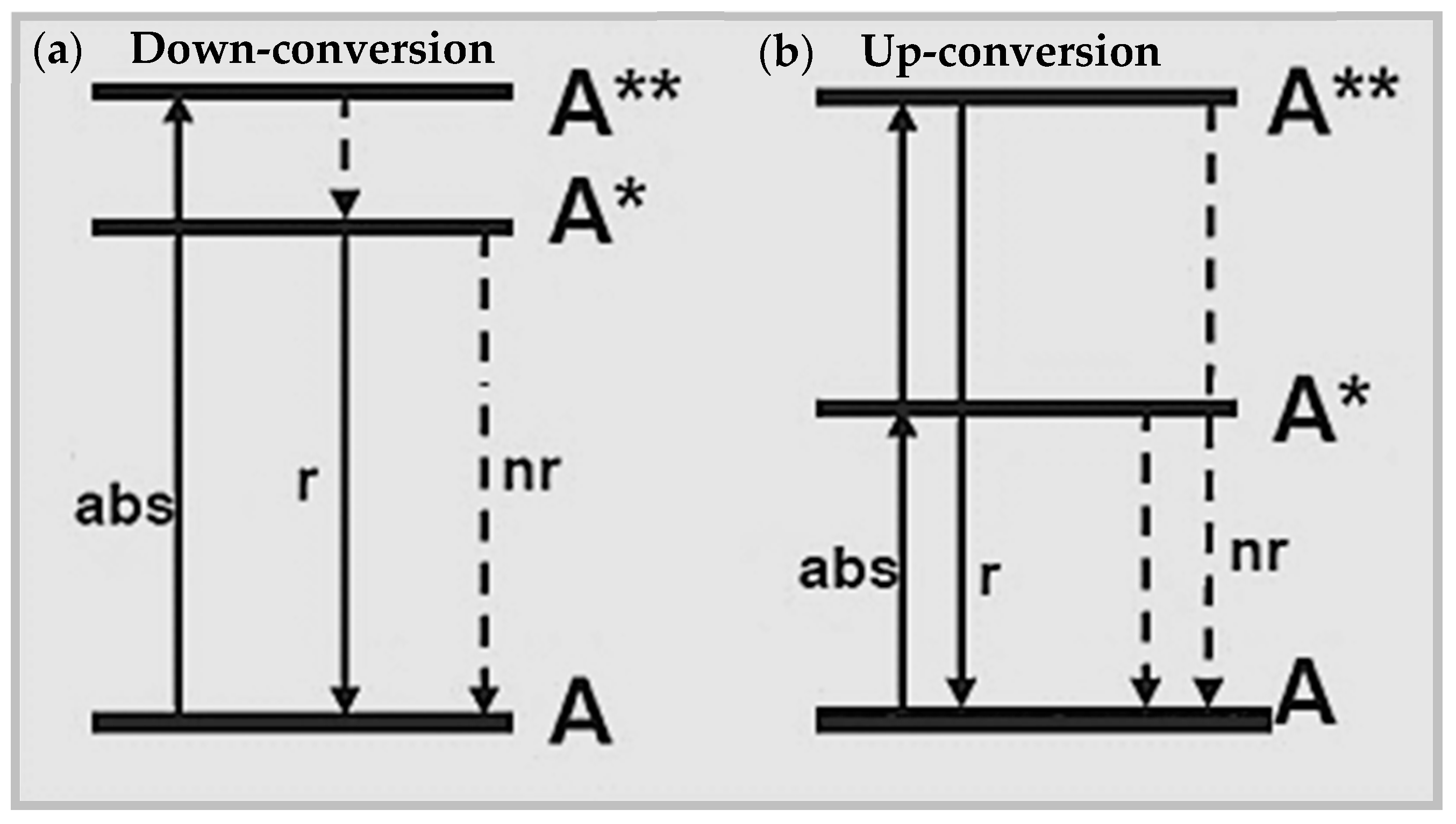
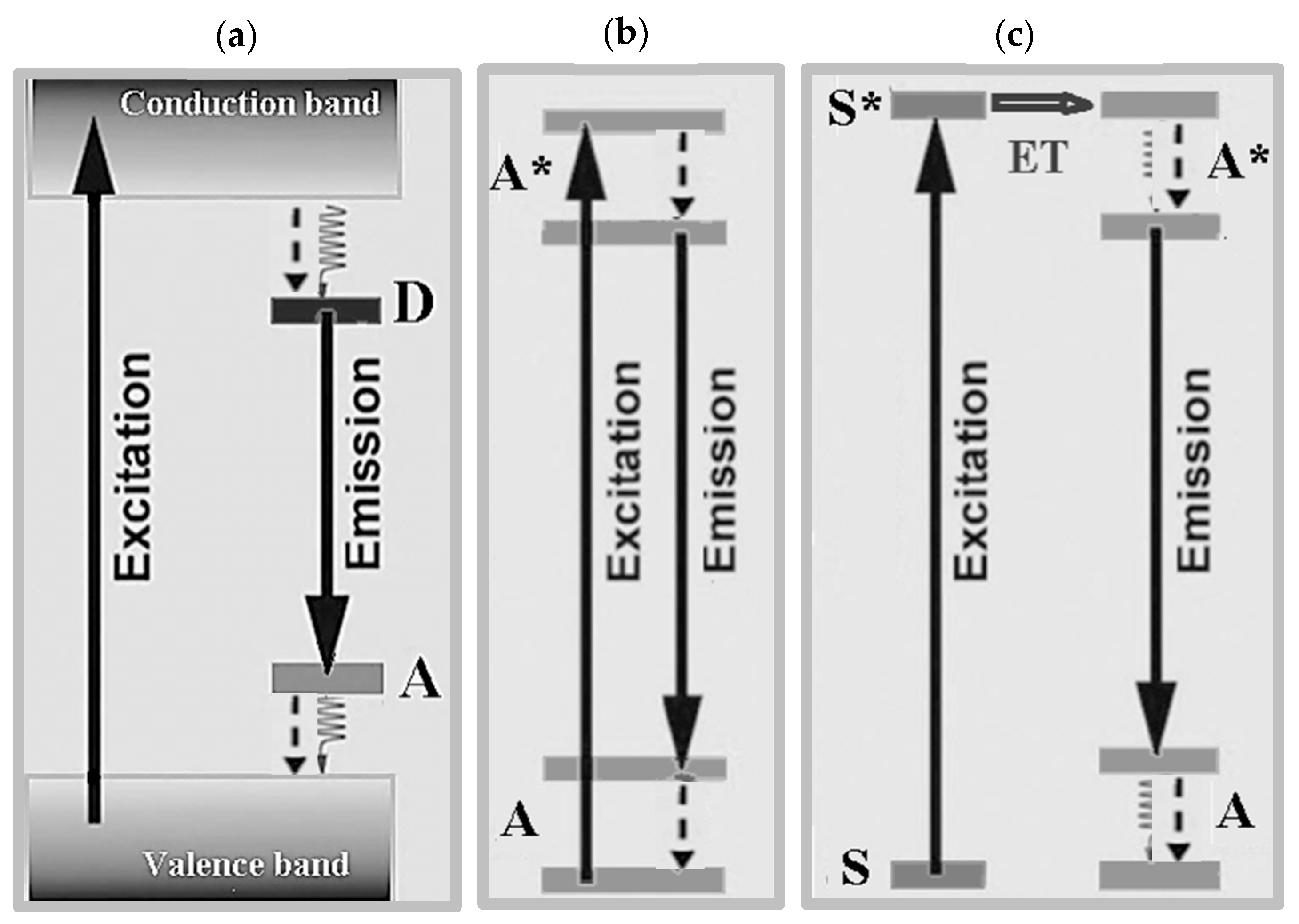
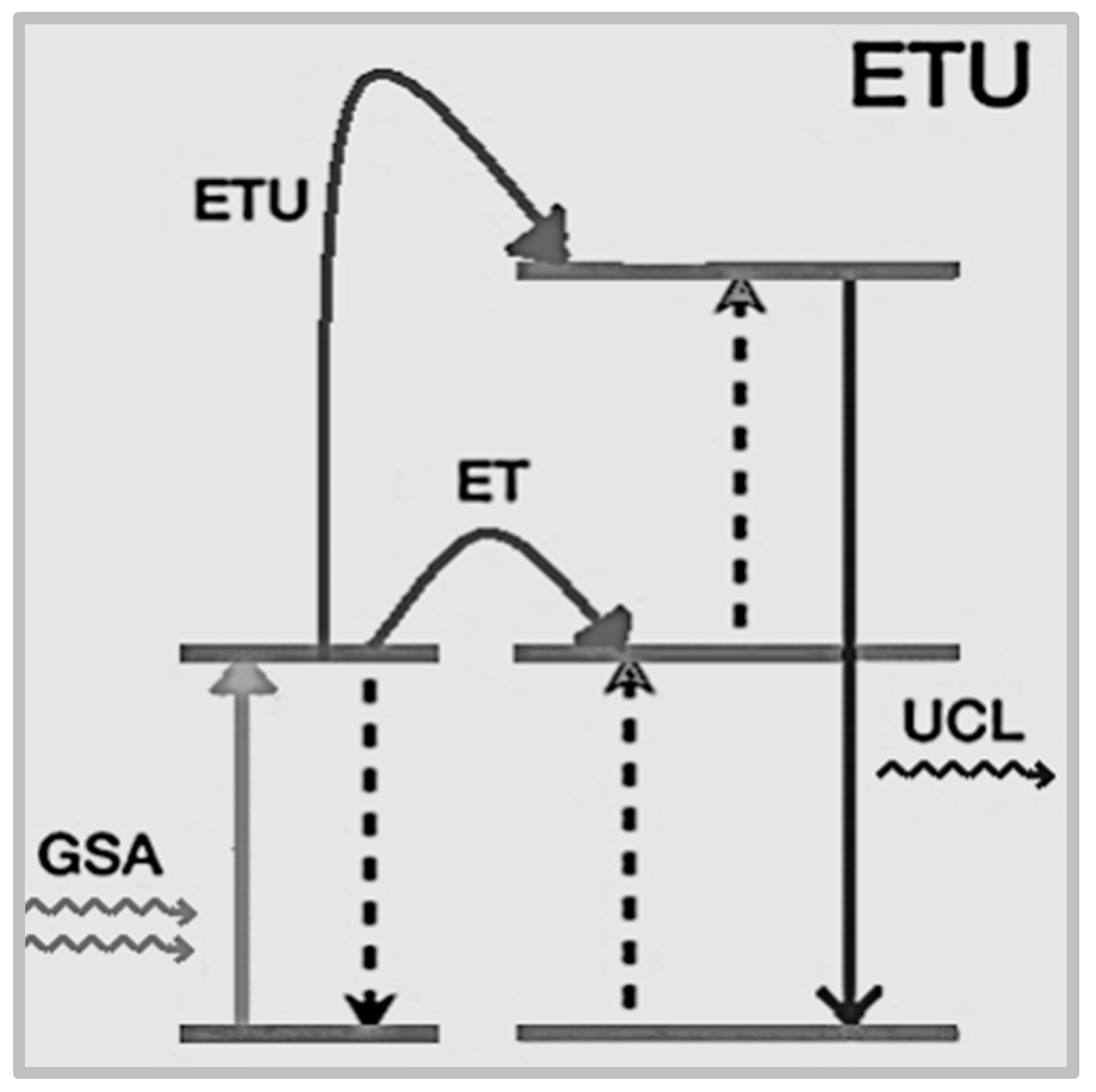
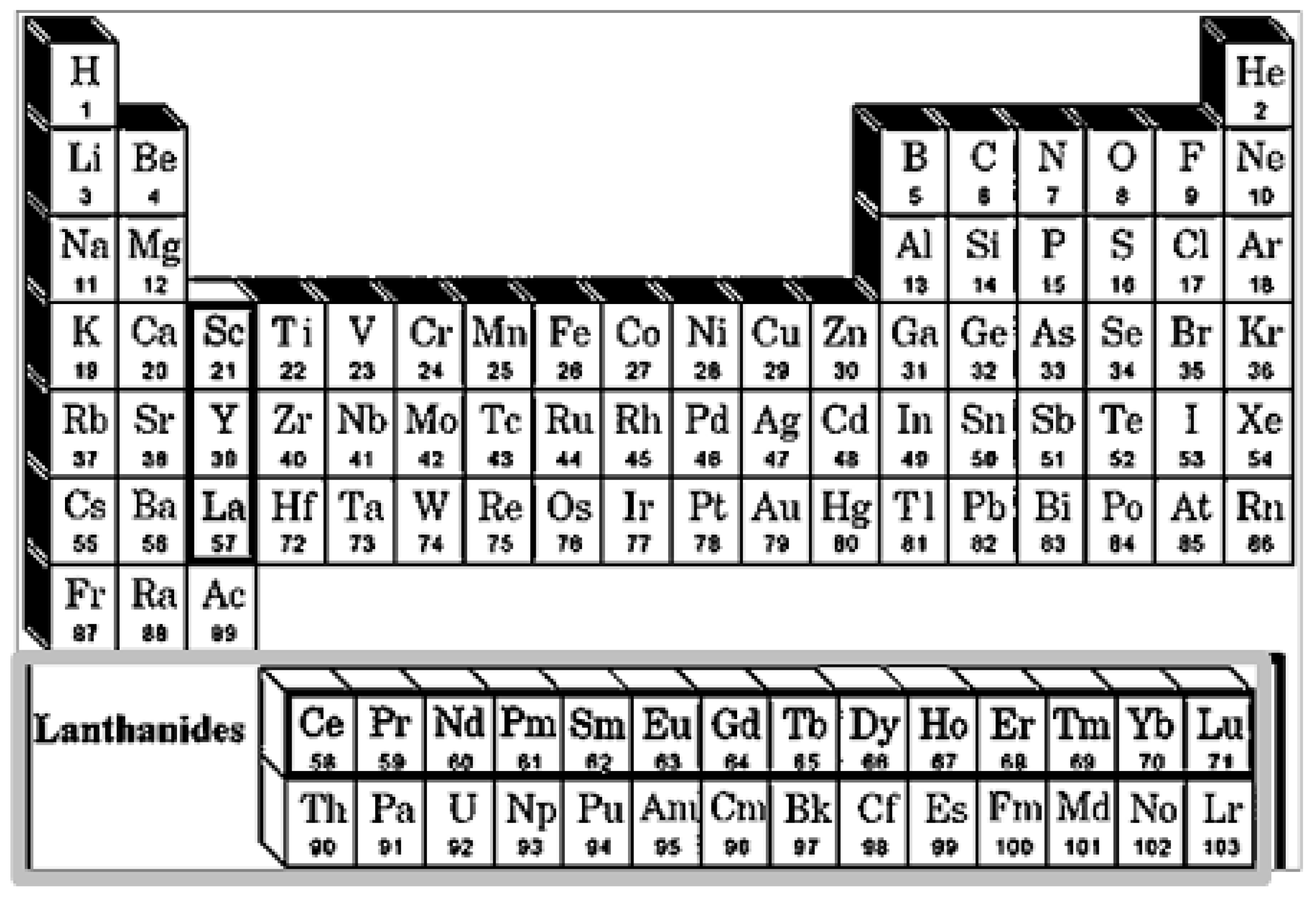
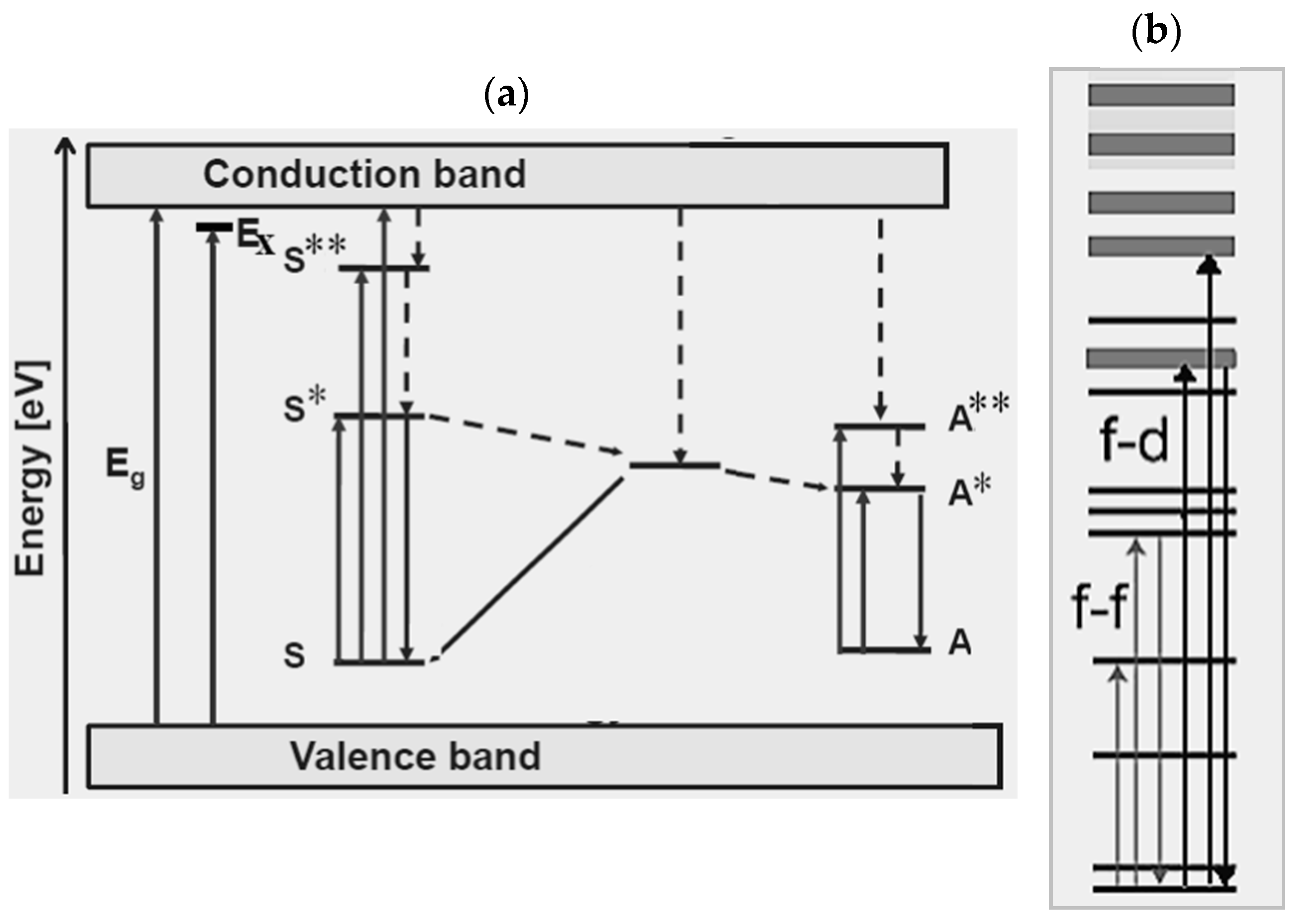
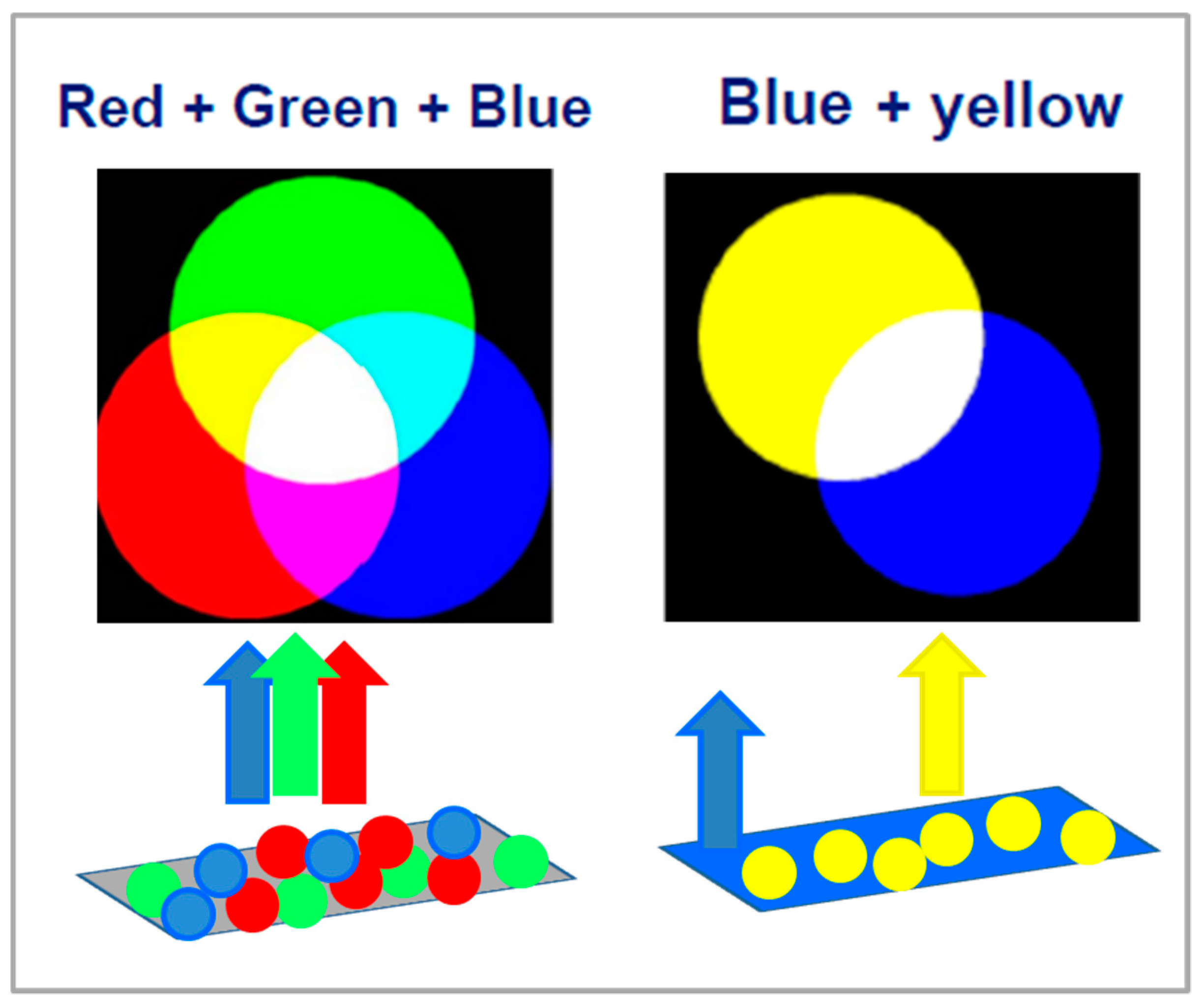
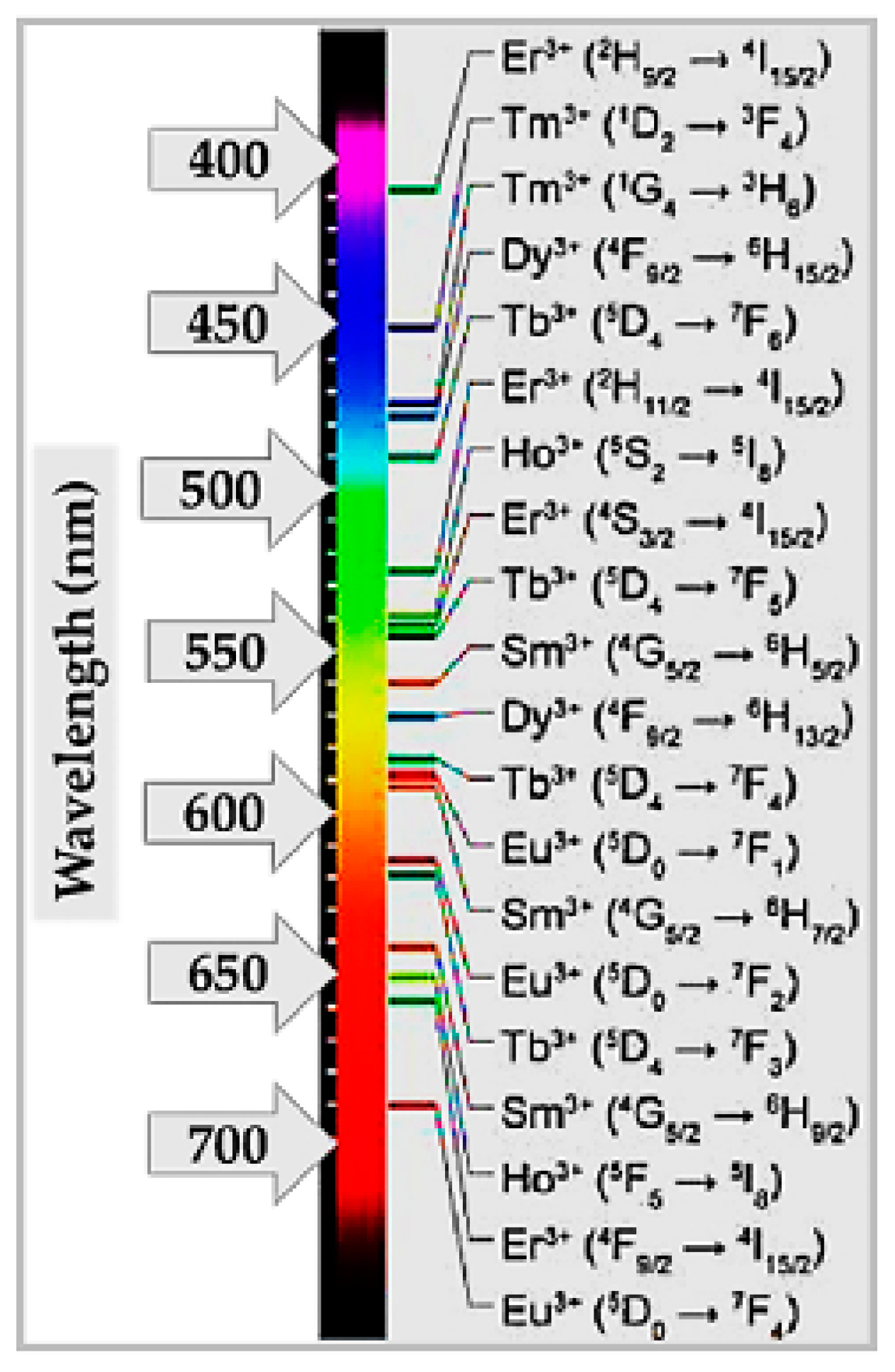
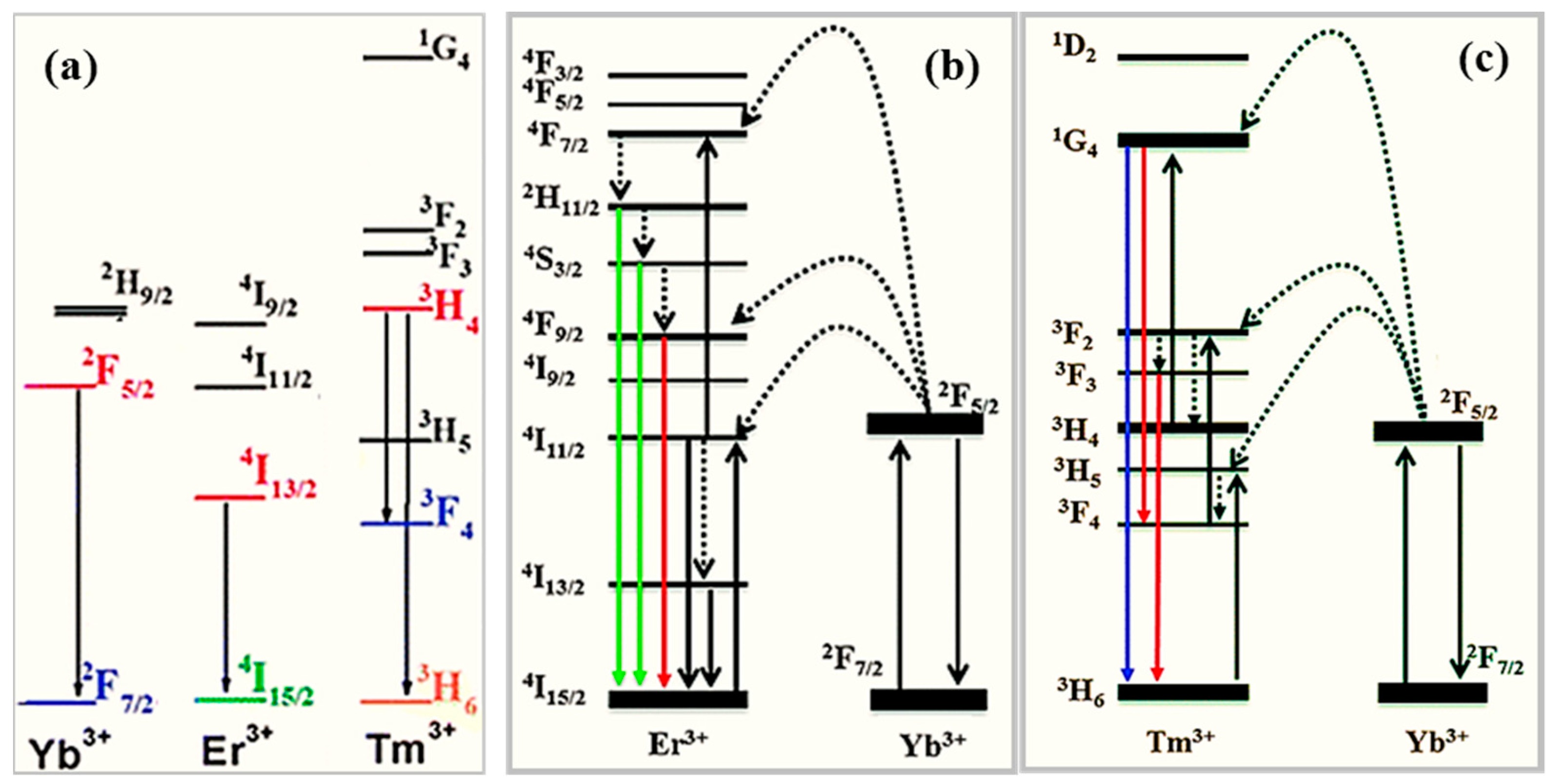
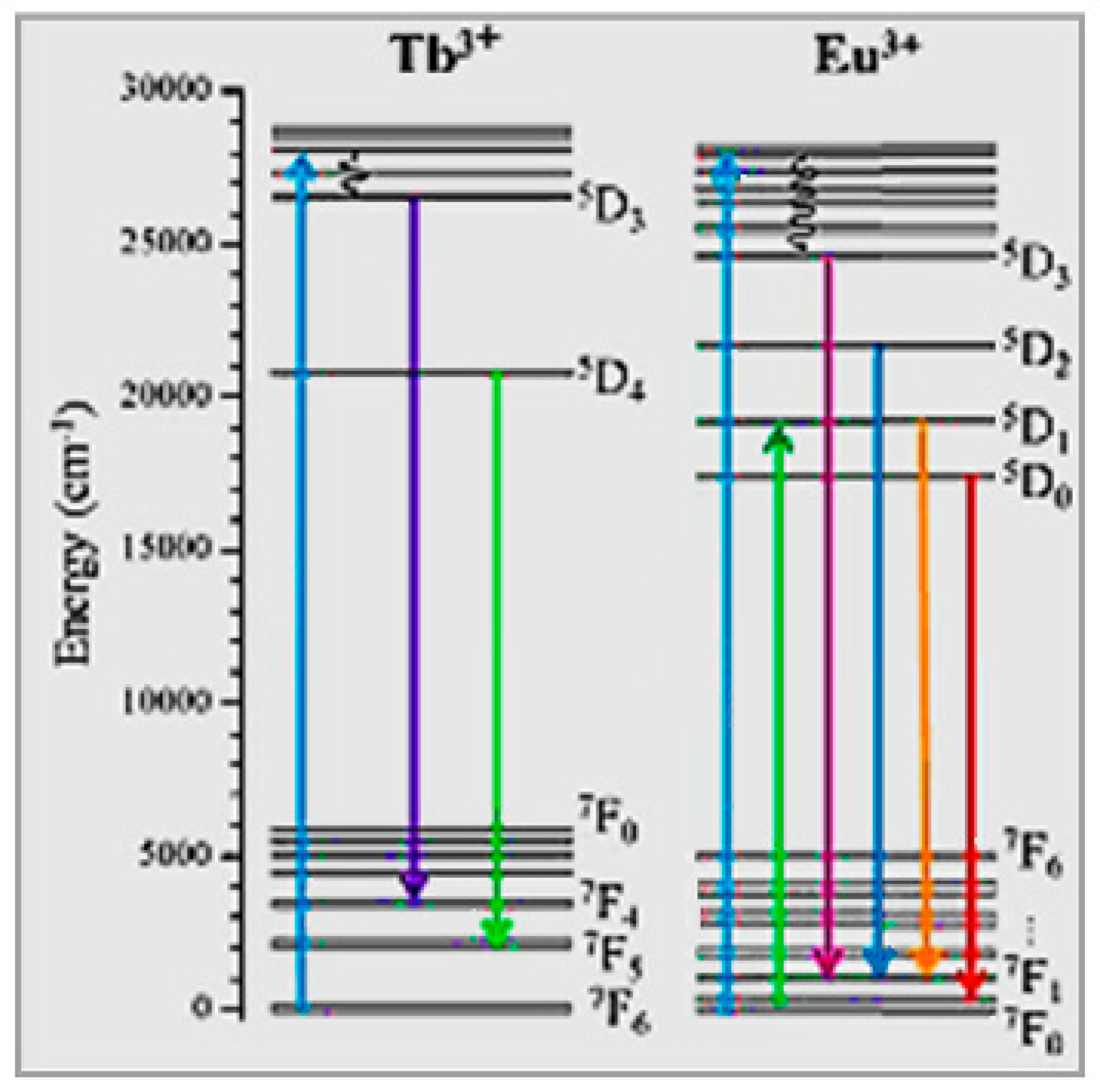
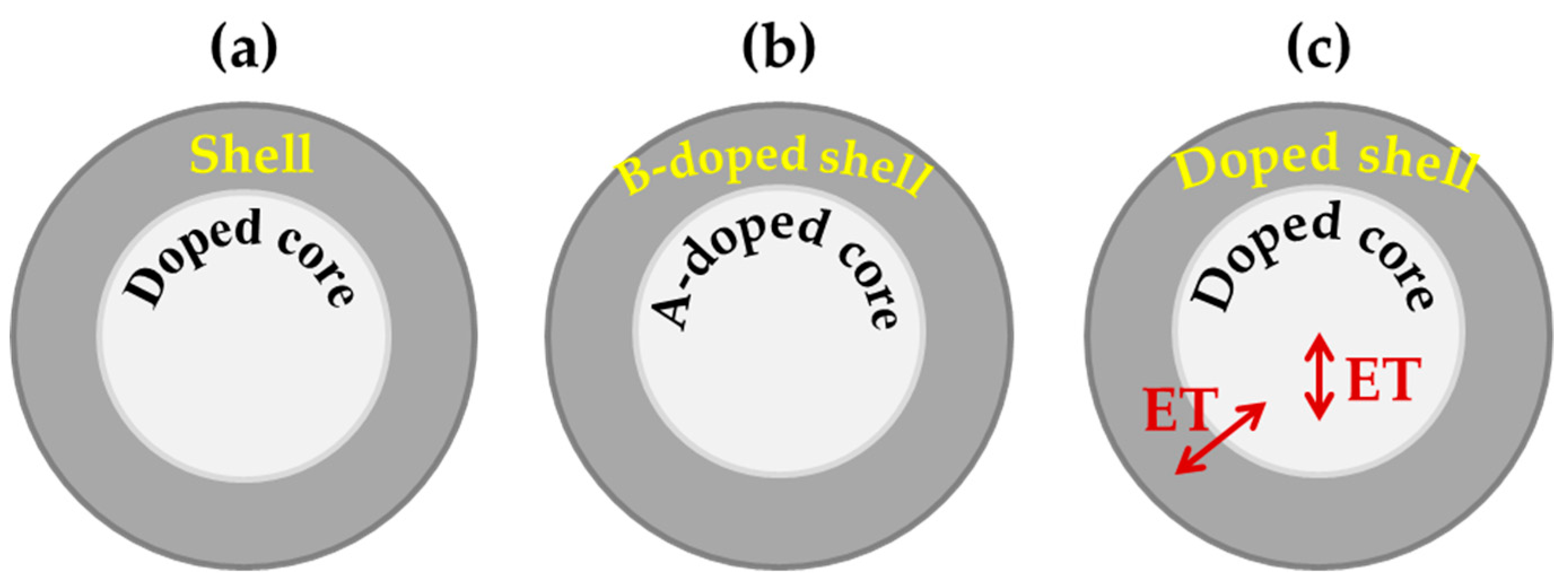
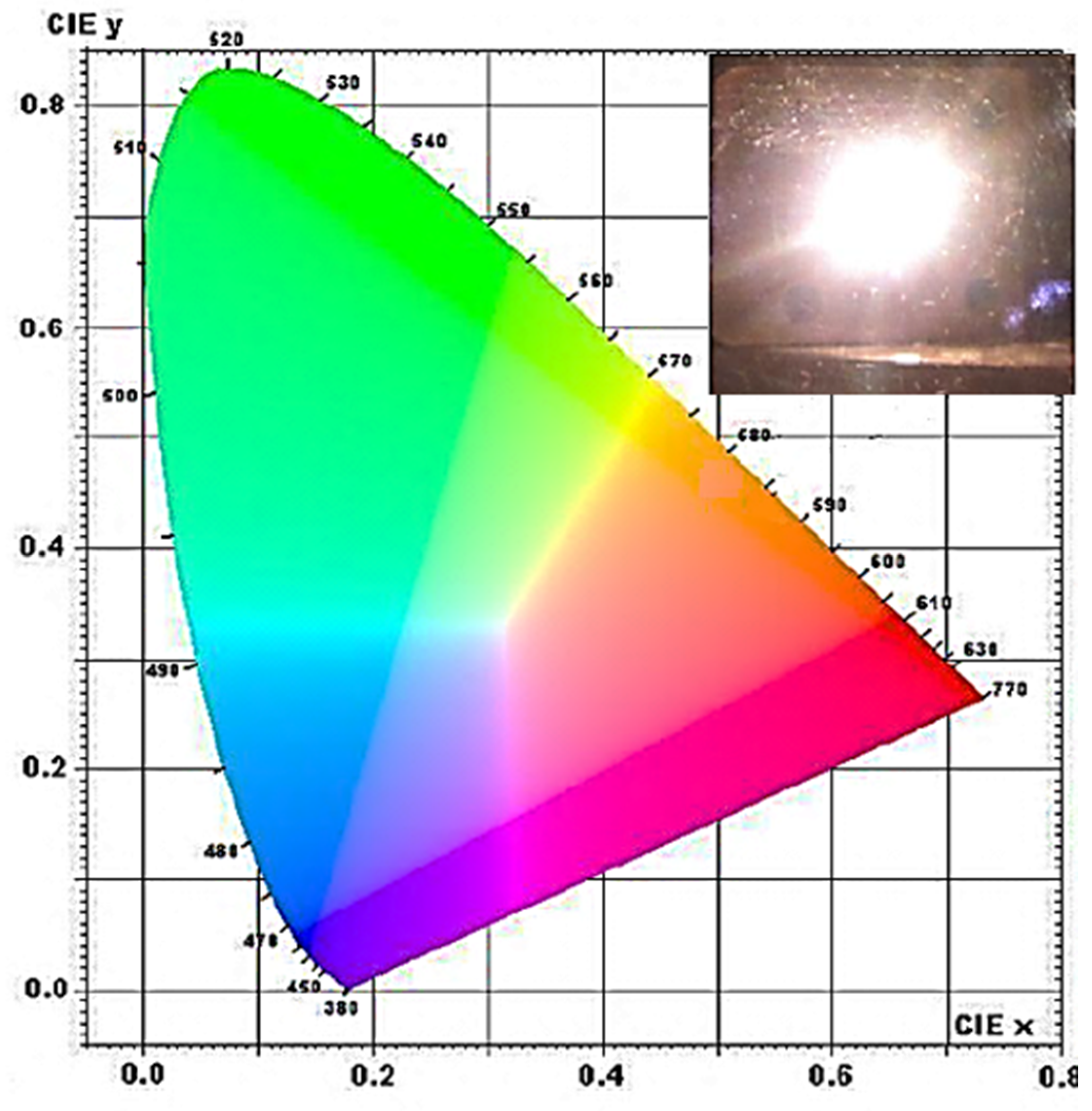
© 2019 by the authors. Licensee MDPI, Basel, Switzerland. This article is an open access article distributed under the terms and conditions of the Creative Commons Attribution (CC BY) license (http://creativecommons.org/licenses/by/4.0/).
Share and Cite
Cesaria, M.; Di Bartolo, B. Nanophosphors-Based White Light Sources. Nanomaterials 2019, 9, 1048. https://doi.org/10.3390/nano9071048
Cesaria M, Di Bartolo B. Nanophosphors-Based White Light Sources. Nanomaterials. 2019; 9(7):1048. https://doi.org/10.3390/nano9071048
Chicago/Turabian StyleCesaria, Maura, and Baldassare Di Bartolo. 2019. "Nanophosphors-Based White Light Sources" Nanomaterials 9, no. 7: 1048. https://doi.org/10.3390/nano9071048
APA StyleCesaria, M., & Di Bartolo, B. (2019). Nanophosphors-Based White Light Sources. Nanomaterials, 9(7), 1048. https://doi.org/10.3390/nano9071048



